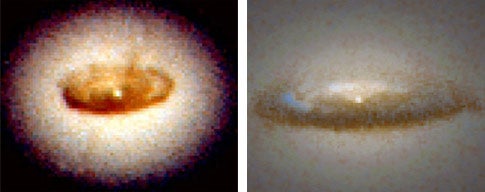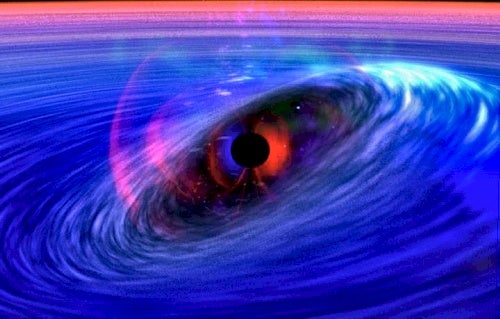The Hubble Space Telescope has imaged a number of dust disks surrounding black holes. Both NGC 4261 (left) and NGC 7052 (right) have thick disks of material surrounding the galaxies’ supermassive black holes. In time, the black holes will devour the dust.
NGC 4261: L. Ferrarese / STScI / NASA; NGC 7052: R. van der Marel (STScI), et al., and NASA
The concept of black holes has evolved immensely since these mysterious objects were first theorized in the late 18th century and later seriously discussed in the 1960s. Today, black holes are still largely a mystery, but scientists are constantly making discoveries about these objects. Here’s a roundup of what they’ve uncovered recently.
Radiation burps
Our galaxy’s supermassive black hole produces bursts of radiation. Scientists led by Farhad Yusef-Zadeh of Northwestern University looked at the center of our galaxy over a large portion of the electromagnetic spectrum (radio, millimeter, submillimeter, infrared, X rays, and soft gamma rays). They found that low-energy and high-energy flares occur simultaneously.
Our galaxy’s supermassive black hole produces bursts of radiation. Scientists led by Farhad Yusef-Zadeh of Northwestern University looked at the center of our galaxy over a large portion of the electromagnetic spectrum (radio, millimeter, submillimeter, infrared, X rays, and soft gamma rays). They found that low-energy and high-energy flares occur simultaneously.
The point of no return
Scientists at MIT and Harvard have found evidence of a black hole’s event horizon, the point beyond which nothing (not even light) can escape. Using NASA’s Rossi X-ray Timing Explorer, scientists observed suspected neutron stars and black holes. Each object is locked in a binary system with a giant star. When gas from the companion flowed to either the neutron star or the black hole, Rossi detected specific signatures. With the neutron star, the gas crashed onto its hard surface, and astronomers detected X-ray bursts. In the case of a black hole, there were no explosions — the matter seemed to fall into a void without hitting anything.
Scientists at MIT and Harvard have found evidence of a black hole’s event horizon, the point beyond which nothing (not even light) can escape. Using NASA’s Rossi X-ray Timing Explorer, scientists observed suspected neutron stars and black holes. Each object is locked in a binary system with a giant star. When gas from the companion flowed to either the neutron star or the black hole, Rossi detected specific signatures. With the neutron star, the gas crashed onto its hard surface, and astronomers detected X-ray bursts. In the case of a black hole, there were no explosions — the matter seemed to fall into a void without hitting anything.
Downward spiral
A group of astrophysicists led by Kambiz Fathi of the Rochester Institute of Technology observed the barred spiral galaxy NGC 1097. They measured the motion of matter streaming from the galaxy’s spiral arms into the center. They estimate it takes debris roughly 200,000 years to travel from 30 light-years out into the central black hole. The group’s observations, made with the Gemini South Telescope in Chile, looked 10 times closer to the central supermassive black hole than ever before.
A group of astrophysicists led by Kambiz Fathi of the Rochester Institute of Technology observed the barred spiral galaxy NGC 1097. They measured the motion of matter streaming from the galaxy’s spiral arms into the center. They estimate it takes debris roughly 200,000 years to travel from 30 light-years out into the central black hole. The group’s observations, made with the Gemini South Telescope in Chile, looked 10 times closer to the central supermassive black hole than ever before.
A Goldilocks black hole
Astronomers at the University of Iowa have detected an intermediate-size black hole in galaxy M82. This object has roughly 1,000 times the mass of our Sun. Over the past decade, scientists have found evidence that a class of medium-size black holes exists; they have masses between 100 and 10,000 our Sun’s. Because not many of these black holes are known, this discovery can help explain how these objects form and evolve.
Astronomers at the University of Iowa have detected an intermediate-size black hole in galaxy M82. This object has roughly 1,000 times the mass of our Sun. Over the past decade, scientists have found evidence that a class of medium-size black holes exists; they have masses between 100 and 10,000 our Sun’s. Because not many of these black holes are known, this discovery can help explain how these objects form and evolve.
Groovy, baby
Scientists have found a black hole that has left a dent in space-time. Using NASA’s Rossi X-ray Timing Explorer, they observed chaotic fluctuations near a black hole in a range of frequencies. The group, led by MIT’s Jeroen Homan, detected patterns in the X-ray light emitted near the black hole in 2005 identical to what they observed in 1996. The oscillations are likely the result of material passing over a groove caused by the black hole’s gravitational warping of space-time.
Scientists have found a black hole that has left a dent in space-time. Using NASA’s Rossi X-ray Timing Explorer, they observed chaotic fluctuations near a black hole in a range of frequencies. The group, led by MIT’s Jeroen Homan, detected patterns in the X-ray light emitted near the black hole in 2005 identical to what they observed in 1996. The oscillations are likely the result of material passing over a groove caused by the black hole’s gravitational warping of space-time.
Black-hole lunch
In the past year, astrophysicists have determined short-duration gamma-ray bursts (GRBs) result from two similar scenarios: neutron-star-to-neutron-star collisions, and black-hole-to-neutron-star collisions. A short GRB detected July 24, 2005, appears to be the result of a black hole and neutron star colliding. In the process, the black hole tore the neutron star apart. Smaller bursts of light followed the initial blast; scientists believe they were from bits of the torn-up neutron star falling into the black hole.











